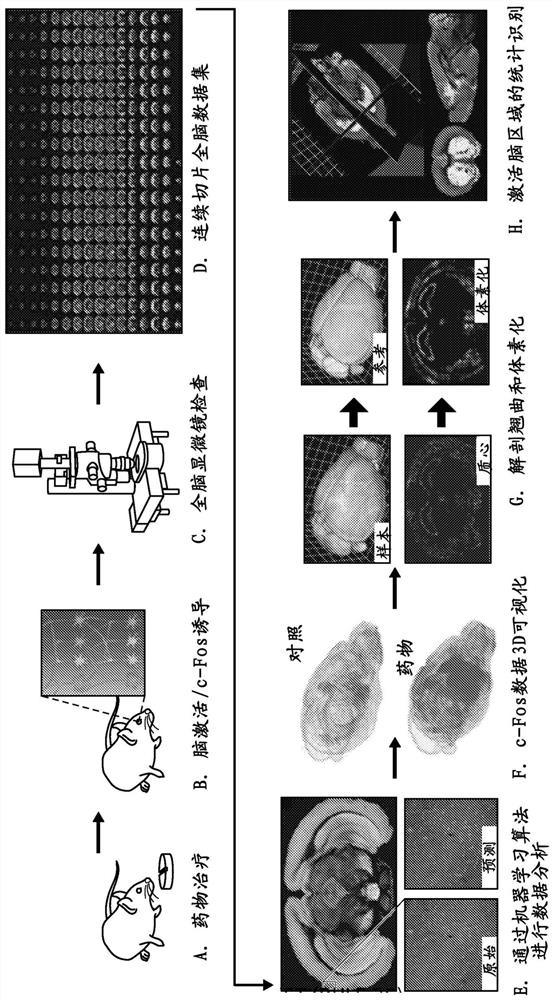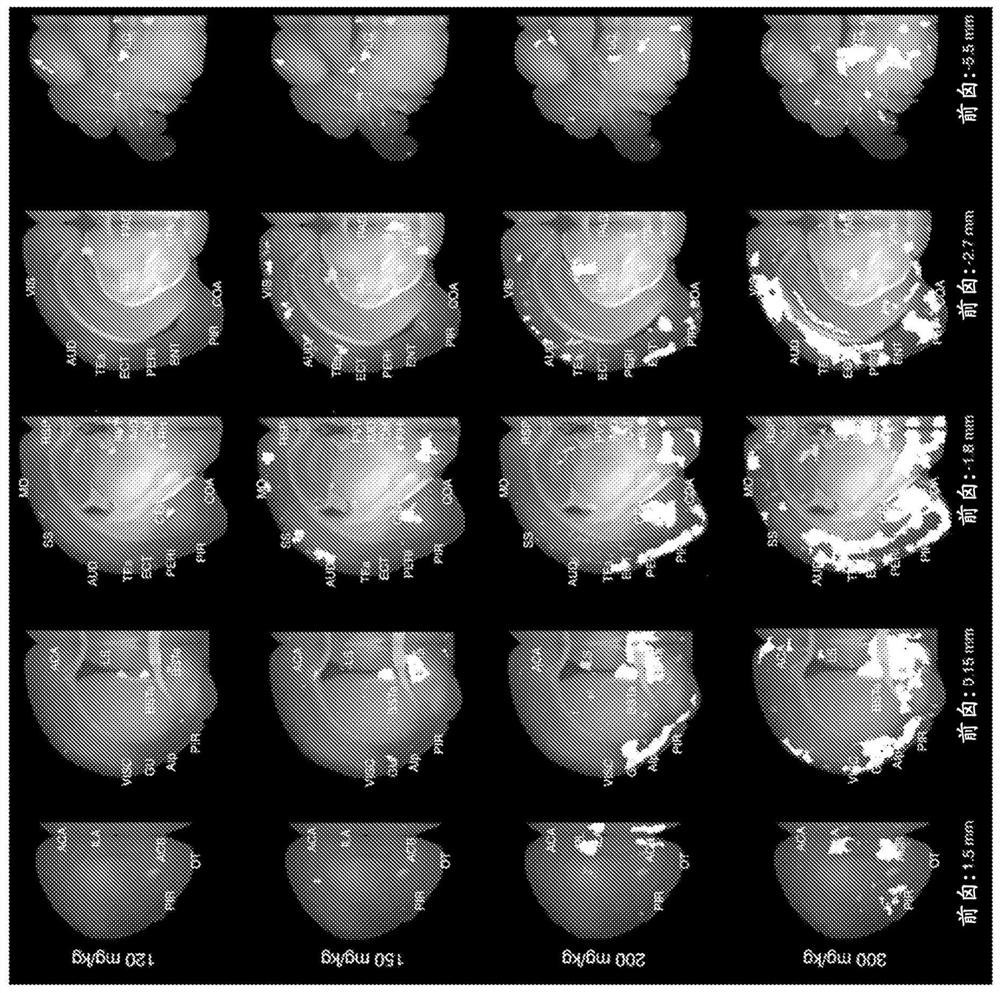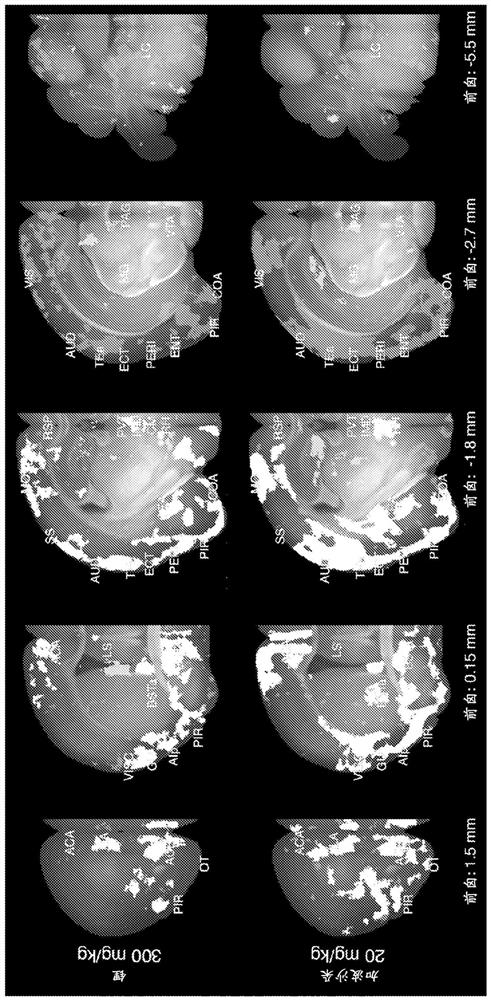Combination of gaboxadol and lithium for treatment of psychiatric disorders
A technology of gaboxadol and composition, which is applied in the field of composition for treating mental disorders, and can solve problems such as acute toxicity of infants
- Summary
- Abstract
- Description
- Claims
- Application Information
AI Technical Summary
Problems solved by technology
Method used
Image
Examples
Embodiment 1
[0305] Example 1: Whole Brain Drug Screening Platform
[0306]Many preclinical trials are currently being used to try to elucidate or predict the clinical effects of new drugs on the brain. These include in vitro high-content screening (HCS) assays that measure the pharmacokinetics of drugs against specific molecular targets and their effects in simple cellular assays, at relatively low resolution (PET / CT, PET / MRI, fMRI) or at high cellular Resolution (electrophysiological or two-photon imaging) in vivo assays that measure local responses, and behavioral assays that measure animal performance in various tasks (Jain and Heutink, 2010; Judenhofer et al., 2008; Markou et al., 2009). Despite the considerable effort invested in preclinical research, the clinical effects of drugs remain unpredictable, plaguing the drug development pipeline and resulting in clinical trial failure rates exceeding 90% (Pammolli et al., 2011).
[0307] To assess neuronal activity in regions that are di...
Embodiment 2
[0312] Example 2: Mapping Brain Activation Under Therapeutic Effects of Lithium in Psychiatry
[0313] To understand the mechanism of action of lithium in the whole brain, the pharmacodynamic mapping technique described above was used to map lithium-induced brain activation in response to the following doses (mg / kg) in mice: 120, 150, 200, and 300, which are approximately equivalent to Human equivalent dose (mg): 600, 750, 1000 and 1500. These experiments revealed dose-dependent increases in brain activation patterns, including modest activation of some structures at 120 and 150 mg / kg and fairly widespread activation at 200 and 400 mg / kg ( figure 2 ). The activation pattern observed with lithium doses of 120 and 150 mg / kg included the anterior portion of the bed nucleus of the stria terminalis (BSTa), the central amygdala (CEA), and the anterior portion of the locus coeruleus (LC) ( figure 2 , top row). In addition to the anterior limbic (PL) and inferior limbic (ILA) cor...
Embodiment 3
[0314] Example 3: Lithium-induced c-fos activation pattern closely matches that of the GABA-A agonist gaboxadol
[0315] The effects of lithium on the mouse brain mapped using the pharmacodynamic mapping platform described above can be directly compared to lithium-induced brain activation patterns and those of other test compounds. Strikingly, the pharmacodynamic pattern evoked by the high dose of 300mg / kg lithium closely matched that of 20mg / kg gaboxadol, including the following c-fos activation: 1) broad cortical activation including exercise (MO), Gustatory (GU), associated visceral (VISC), agranular insula (AI), somatosensory (SS), auditory, visual (VIS), auditory (AUD), anterior (PL) and inferior (ILA), postpressor (RSP), parietal lobe (PTL), temporal association (TEa), extorhinal (ECT), entorhinal (ENT), perirhinal (PERI), piriform (PIR) and anterior cingulate (ACA) cortices, claustrum (CLA), and 2) subcortical activation, including the CA1 region of the hippocampus, th...
PUM
 Login to View More
Login to View More Abstract
Description
Claims
Application Information
 Login to View More
Login to View More - R&D
- Intellectual Property
- Life Sciences
- Materials
- Tech Scout
- Unparalleled Data Quality
- Higher Quality Content
- 60% Fewer Hallucinations
Browse by: Latest US Patents, China's latest patents, Technical Efficacy Thesaurus, Application Domain, Technology Topic, Popular Technical Reports.
© 2025 PatSnap. All rights reserved.Legal|Privacy policy|Modern Slavery Act Transparency Statement|Sitemap|About US| Contact US: help@patsnap.com



